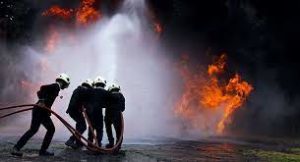 Often people confuse fire partitions and fire barriers. Although they do have some similarities, they are quite different from each other. There are many different types of fire partitions and fire barriers, and the best one for your needs depends on your building. The International Building Code (IBC) defines these as interior walls that prevent the spread of fire or smoke. They are typically made of gypsum, drywall, or cement board. Get the facts about Understanding the Differences Between Fire Partitions and Fire Barriers see this.
Often people confuse fire partitions and fire barriers. Although they do have some similarities, they are quite different from each other. There are many different types of fire partitions and fire barriers, and the best one for your needs depends on your building. The International Building Code (IBC) defines these as interior walls that prevent the spread of fire or smoke. They are typically made of gypsum, drywall, or cement board. Get the facts about Understanding the Differences Between Fire Partitions and Fire Barriers see this.
Fire partitions are commonly used in dormitories, shopping malls, and hotels. The main purpose of a fire partition is to stop the spread of smoke. They are also used to partition off a room or area, to separate occupancies, or to limit the size of a fire area. They are also used to protect exit stair enclosures. However, some fire partitions are structurally independent, meaning they are not installed as permanent barriers. They can be added after construction.
The best fire barrier is a fire wall, because it provides continuous protection against fire. It also provides a way to compartmentalize a building, which may be especially useful in a multi-occupancy building. In addition, fire walls are often used to tie new construction to existing structures. In fact, some fire walls are used to separate two buildings, at the lot line, by fire.
Fire partitions and fire barriers are essential to building safety plans. These two elements are critical to preventing fire from spreading and to protecting critical equipment and infrastructure. In addition, they can help to save time during an evacuation. Fire barriers and partitions also prevent employees from being exposed to smoke or virus.
Both fire partitions and fire barriers are required to be tested by the NFPA 80 Standard for Fire Doors and Windows. These doors and windows should be self-closing and able to withstand temperatures of 750 degrees Fahrenheit. They should also be labeled and tested after installation. They should also have a fire-resistance rating of at least one hour. They should also be airtight on the fire side. They should be designed with a fire-resistance rating that matches the fire-resistance rating of the supporting construction.
Fire partitions are a great way to separate different areas in a building, such as a lobby or a reception area. Fire walls are also useful in protecting buildings from fire, as they are typically made of concrete blocks or wood-framed studs. However, these structures can be difficult to build and require specialized equipment. The construction of these structures varies depending on the type of building.
The International Building Code requires fire barriers to be rated for at least one hour of fire resistance. This rating is the minimum required for a fire wall, but it is recommended that you choose a fire barrier that has a fire-resistance rating at least two hours. If you plan to install a fire barrier in your building, you will also need to decide whether you need a vertical or horizontal assembly. This depends on how large the walls are, and what kind of traffic is expected in the space.